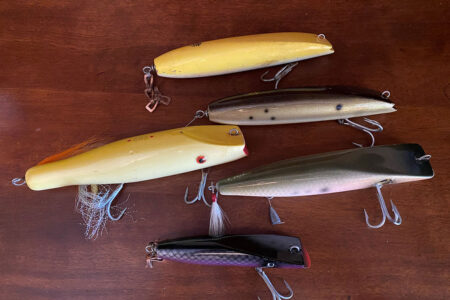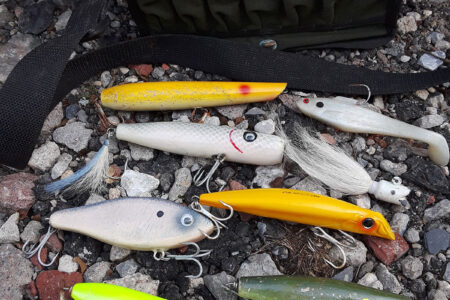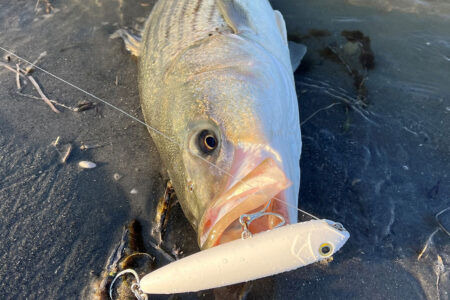Savvy casters understand that adapting your tackle and techniques to the fish you are targeting is key to early season success.
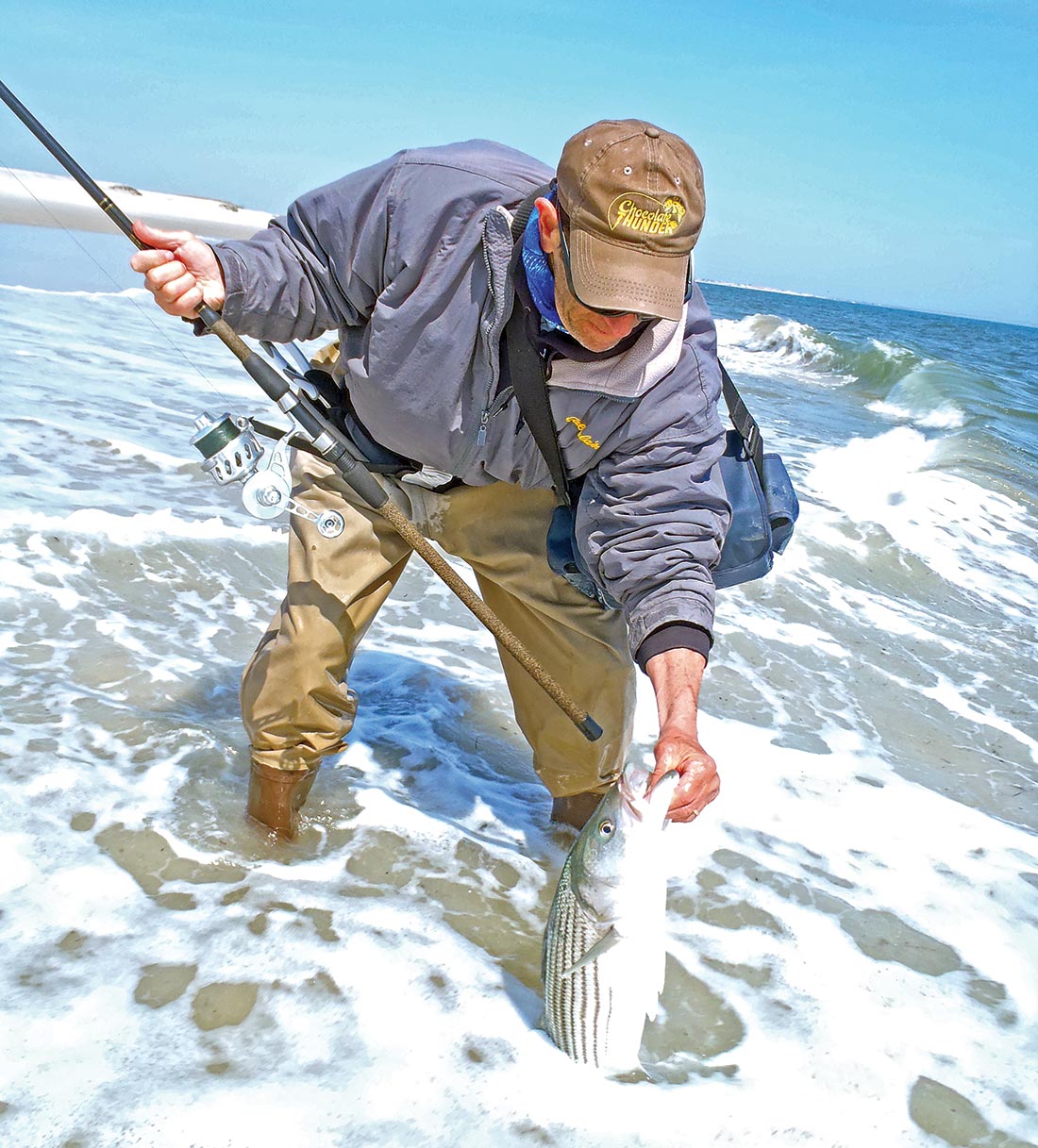
Well, after almost four decades trying to persuade the ASFMC and MARFMC that bluefish stocks were declining rapidly, fisheries managers have finally taken notice. Thanks to a very sad stock assessment they concluded that bluefish stocks are in big trouble, and recently made drastic changes in the management rules. In 2020, the bag limit will be three fish per person per day of any size for independent anglers, and five fish per person on for-hire boats. Now, it’s up to nature to produce some good spawning year classes if the new rules are to have positive impact. Now more than ever, anglers need to seriously think in terms of catch and release for bluefish.
On the other hand, striped bass stocks are in better shape, if not great, and dominated by small fish in surf venues. Certainly, the quality of striped bass fishing today doesn’t match that of the 1990s, and hopefully the new striper regulations that include a slot limit (28-35 inches) will help grow the stock to 1990s levels.
The realities of bluefish and striped bass stocks mean early season fishing is likely to be different from recent years in and around South Shore inlets this May. That is, some small, medium, and large blues are likely to make brief appearances in the usual spots this May, but they are also likely to come and go, and the number of fish caught on a given day will be down. However, just as it was true in 2019, there is a good chance that winter hold-over stripers (probably mostly Hudson fish), will pop up at the same locales. In spring 2019, surf anglers caught mostly school stripers at the inlets and along the beaches adjacent to the inlets, especially in April. As always, success depends on how much bait is present close to shore. Last spring the bait that triggered the striper bite was sand eels, but other baits may make appearances in May including squid, pilchards, and adult bunker. Of course, adult bunker typically interest larger bluefish more than school stripers, but regardless of bait type, without large schools of blues it is not likely the predators will be able to keep bait consistently close to the beach. I don’t know what your May experience was like in 2019, but I was never present for the big blues, although a few friends managed some. I did catch some school bass and small blues, but I was very disappointed because I love catching teen-size blues.
An Issue of Techniques
Although I plan no adjustments to my rod and reel in 2020, lure selection and presentation techniques will require some tweaking. I’ll stick with my medium power fast action 9-foot rod and VS 200, the same I’ve used in the past for May blues. However, where once popping plugs, pencil poppers, large tins, and large bucktails dominated my arsenal, in 2020 I’m thinking I’ll need to be prepared for smaller fish, too. Preparing for different species and sizes may present a problem for some anglers, but not for others. The latter always fill their bags with a variety of shapes, sizes, and colors and when they select a lure it comes out trailing a dozen other lures. This is not my style. Long ago I decided I did not want to spend time untangling a Christmas tree of lures, carrying extra weight on my shoulder, and having more choices than I would ever use or need in a day. So, my bag is rather stark and limited to a small arsenal. Almost everything in the bag is either white or some color on top with a white belly. In addition, I actually practice what I preach at seminars and in articles: I change my presentation before I change my lure. I believe making good presentations to feeding fish are far more important than the particular characteristics of the lure most of the time.
My May Bag
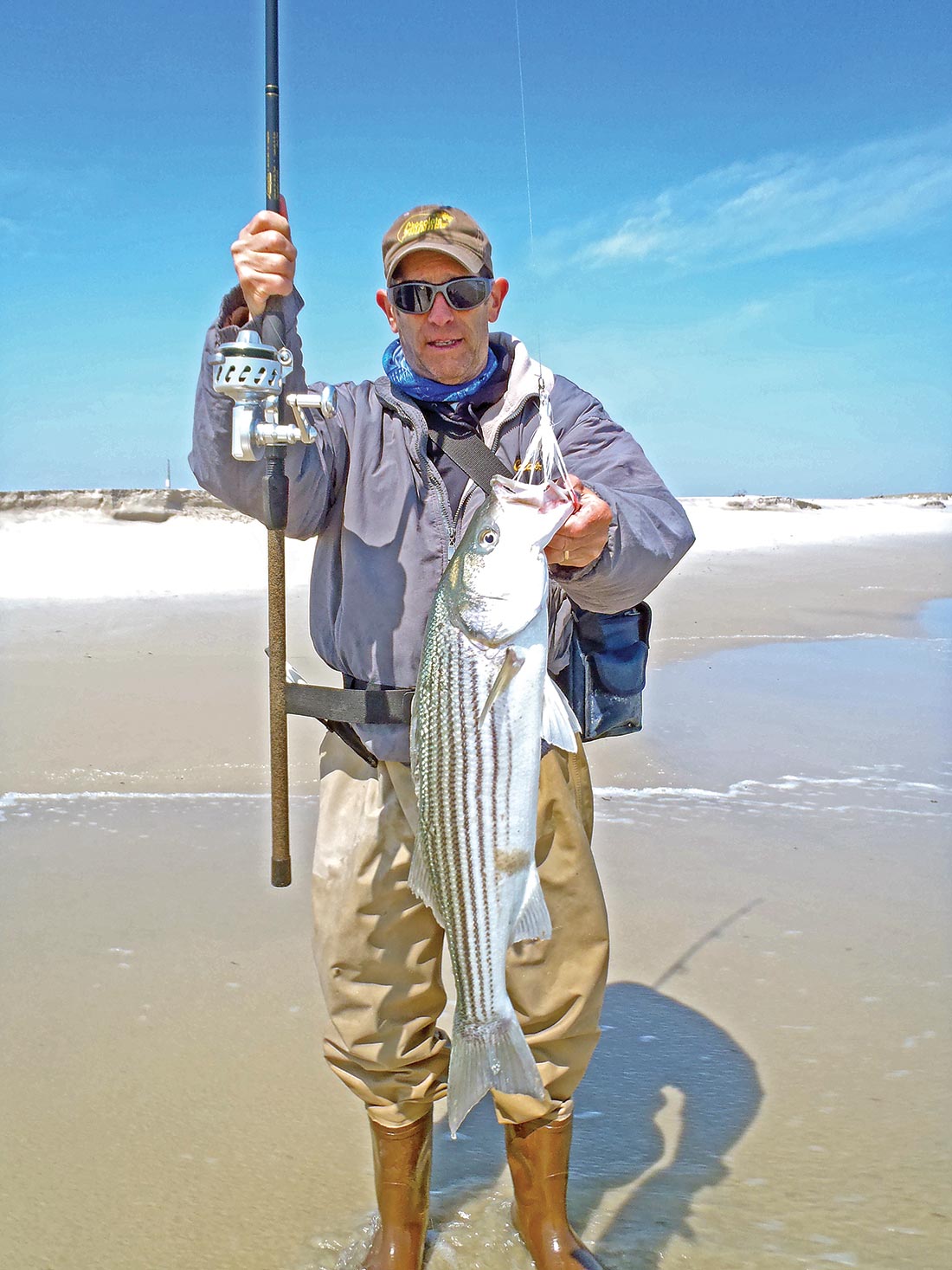
First of all, I use a small bag. It only contains four tubes. I rarely put more than one plug in each tube, but will double up when the plugs are small. I place a few tins in the canvas slots behind the plug tubes: several Charlie Graves styles including J-6, J-7, and D-5 models. Since I anticipate at least some school stripers this spring, I also carry a few 3/4- and 1-ounce lead heads armed with soft plastics. I prefer paddle tail styles over curly tail models, and in May 4- and 5-inch plastics rather than larger ones. I never use a teaser when fishing for bluefish, or cast soft plastic unless I’m reasonably certain there are no blues around.
I always carry bucktails. Decades ago, John Schauer showed me an efficient way to carry bucktails. He made a row of twelve 3/4-inch PVC tubes that he fused together with PVC glue. The line of tubes is placed in front of the plug tubes and each holds one bucktail, and that allows me to select quickly and efficiently. My bucktails are typically white and range from 3/4-ounce to 1-1/2-ounce sizes. I stocked up on Uncle Josh pork rinds before they stopped producing them and have kept them in my basement refrigerator where the cold and brine keep them good as new. I almost always use red and white rind, but yellow and white is second, and white is a third choice. In the final analysis, confidence in your lure should never be underestimated. So, if you have confidence in green bucktails and white rind, I say go for it! However, I urge anglers not to overlook the value of simplicity. A bag with limited choices means the angler does not spend time thinking about what to use, and also removes the urge to constantly change the lure. Finally, limited choices also motivates us to work on presentations.
Tides
Before discussing presentations, it’s worth spending a moment or two talking about tides especially since much of the fishing occurs inside our inlets. I have a few suggestions. First, know the inlet where you fish most often. Although outgoing current is generally best at the inlets, there are inlets where incoming current is better. Try to narrow your tide choice down to the two or three best hours. Also, the time between high tide and the start of the outgoing current is different in each inlet. Finally, the entire length of any inlet isn’t generally productive. Instead, because of twists, bends, and bottom structures, more bait and thus more fish will tend to accumulate in some spots, and either be absent or thin out in others. Again, know how your inlet works. If there are sand eels along the open beach there will be fish there too, especially stripers. In the “front” or ocean beach, there is basically no difference between high tide and current because most of the time there is no current. Any water flow that might occur is not associated with tidal pull, rather wind and waves. Thus, my choice of when to fish the “front” is dictated only by tide stage, and I tend to prefer the last three hours of the outgoing and the beginning of the incoming tides.
Presentations
Once upon a time, almost all the fish running up and down the inlets in May were big blues, and good presentations were less crucial. That is, when the blues would swim through, they would eat almost anything thrown at them on most days. Not because blues are more ravenous than other species as some anglers believe, rather because they had just come off the spawn on the western edge of the Gulf Stream, and were energy depleted and very hungry. They eat as much as they can while the bait schools are present in order to put on a little weight and thicken up.
However, now that we have fewer blues and with some stripers and perhaps a few weakfish feeding with them, presentations that vary in style as well as being precise are more essential. In the 2020 world of surf angling, the smart angler will be prepared, thoughtful, and adaptive.
In my case, since my first objective is to catch big blues, I begin with either a 2-3/8-ounce Super Strike Little Neck Popper, a Gibbs pencil popper, or a one to 1-1/2-ounce bucktail. If schools of large blues are coming and going, I’ll stick with these lures, but if they aren’t, I’ll reevaluate. There are usually tidbits of information that motivate an angler to change strategies. For instance, if I don’t catch a large blue but catch a few small ones, if a large bucktail is hit repeatedly without catching a fish, or if I catch a school striper or two, then I know I need to make changes.
First Choice
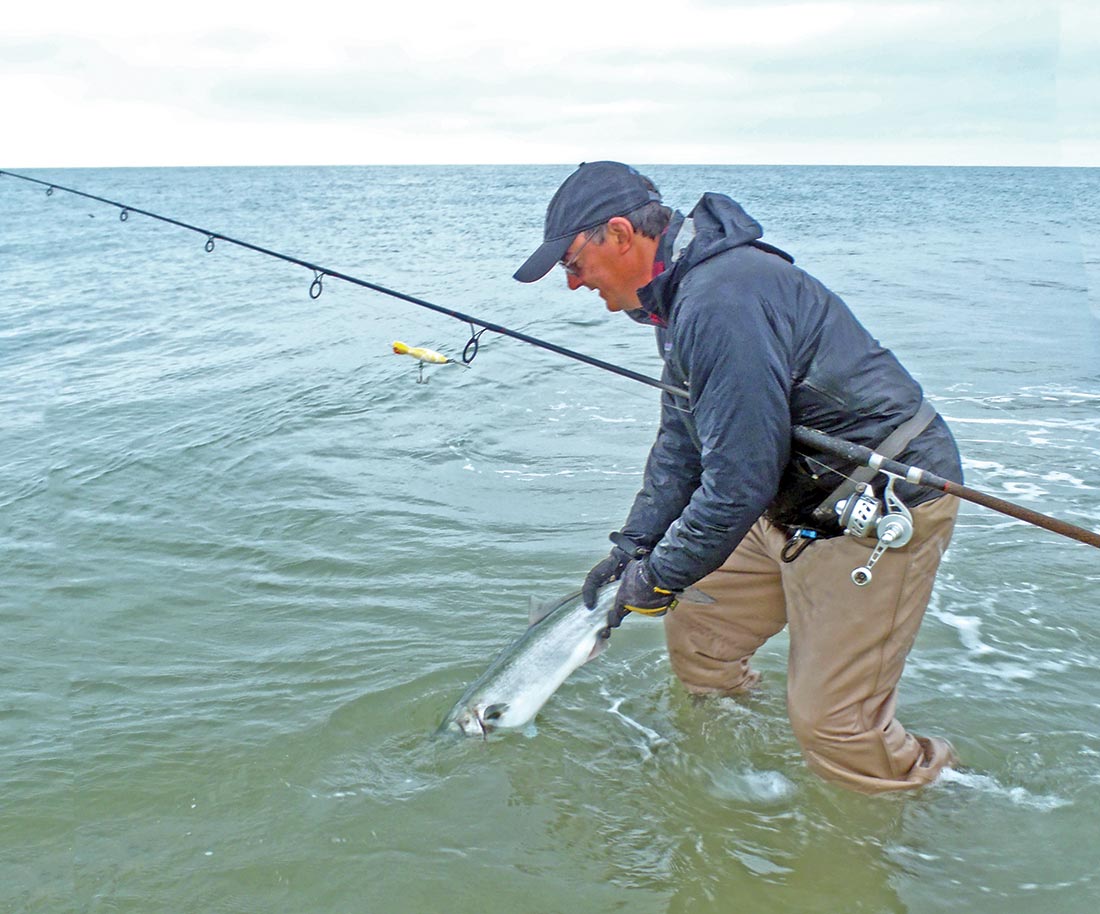
When stripers and blues are small, my first choice will be a smaller bucktail for two reasons. First, a bucktail is somewhat durable against the teeth of bluefish and if one comes by and attacks my lure, the bucktail will likely survive the experience. Second, a 3/4- to 1-ounce bucktail is more likely to attract a hit and secure a hook-up from school bass than large plugs and bucktails. My second choice is a paddle tail soft plastic lure fitted to a lead-head of similar weight to the bucktails. I won’t use them if blues are being landed nearby. However, I have observed that sometimes school stripers react better to the subtle wiggle of a soft plastic lure compared to tins or bucktails.I rarely just cast and crank a lure because I believe an angler will catch many more fish with a variety of retrieves that vary from bold to subtle. I’m always striving to find the best presentation (lure and retrieve) on that tide, day, and considering the weather and water conditions. Even when stripers are in a positive feeding mode, they may still be selective, so I explore many retrieves for each style lure in a systematic way. Making just one or two casts with a different lure or retrieve mode will not provide the angler with enough data to make a decision about whether or not that lure or presentation is effective. Although I am reluctant to switch lures, when I do switch, I make a dozen focused casts and retrieves before deciding to switch again. This approach doesn’t guarantee success, but does improve the odds.
Confidence
It bears saying again that confidence is a big part of success. Over the years I’ve developed tremendous confidence in the lure styles, sizes, and colors in my bag. Another angler might have some of those lures in his/her bag, but might also have a lure or two that he/she has great confidence in that aren’t in my bag. Probably, if I tried one of his/her favorites that I don’t use, or they tried one of mine, neither of us would be as successful as we might have been had we used one of our “confidence” lures. So, the moral of the story is, use those products you believe in. However, to grow as an angler, it is important to have an open mind and constantly be expanding the universe of your confidence. I’ve done that over the years by including a lure style in my bag that I’ve either never used or one that I’ve used but lack confidence in. However, carrying it is not enough and you need to commit to use it during your outings. The more diverse your lure arsenal and array of presentations the more successful you will be.
